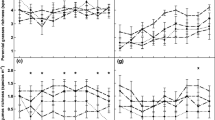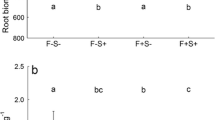Abstract
Protection of biodiversity and restoration of species-rich plant communities rely on an adequate understanding of how diversity is regulated. We studied species diversity patterns and community assembly in a simulated three-year wetland succession using factorial combinations of two nutrient levels, two water levels, and three water level fluctuation regimes. A standard seed mixture of 23 wetland species representing a wide range of plant functional types was sown in each microcosm. We found strong and consistent effects of water depth and nutrient level on species composition, species richness, and biomass, but no clear effect of water level fluctuations. The relationship between biomass and species richness was positive in the infertile range (16 to 204 g m−2) but negative in the fertile range (372 to 1156 g m−2). This pattern is consistent with the “humped-back model”, with maximum species richness at an above ground biomass between 200 and 250 g m−2. Increasing species richness in the low fertility range could partly be explained by limited seedling establishment in the harsh environment of nutrient poor and water logged soils. We interpret the decreasing species richness at high fertility as an effect of increasing competitive asymmetry.
Similar content being viewed by others
Literature Cited
Al-mufti, M. M., C. L. Sydes, S. B. Furness, J. P. Grime, and S. R. Band. 1977. A quantitative analysis of shoot phenology and dominance in herbaceous vegetation. Journal of Ecology 65: 759–91.
Anon. 1999. S-Plus 2000 Professional release 2. 1988–1999 Mathsoft Inc., Seattle, WA, USA.
Burke, M. J. W. and J. P. Grime. 1996. An experimental study of plant community invasibility. Ecology 77: 776–90.
Casanova, M. T. and M. A. Brock. 2000. How do depth, duration and frequency of flooding influence the establishment of wetland plant communities? Plant Ecology 147: 237–50.
Chambers, J. M. and T. J. Hastie. 1993. Statistical Models in S. Chapman and Hall, New York, NY, USA.
Chiarucci, A., C. Alongi, and J. B. Wilson. 2004. Competitive exclusion and the No-Interaction model operate simultaneously in microcosm plant communities. Journal of Vegetation Science 15: 789–96.
Connell, J. H. 1978. Diversity in tropical rain forests and coral reefs — High diversity of trees and corals is maintained only in a non-equilibrium state. Science 199: 1302–10.
Cornwell, W. K. and P. J. Grubb. 2003. Regional and local patterns in plant species richness with respect to resource availability. Oikos 100: 417–28.
Day, R. T., P. A. Keddy, J. McNeil, and T. Carleton. 1988. Fertility and disturbance gradients: a summary model for riverine marsh vegetation. Ecology 69: 1044–54.
Ditommaso, A. and L. W. Aarssen. 1991. Effect of nutrient level on competition intensity in the field for three coexisting grass species. Journal of Vegetation Science 2: 513–22.
Ejrnæs, R., H. H. Bruun, and B. J. Graae. 2006. Community assembly in experimental grasslands: suitable environment or timely arrival? Ecology 87: 1225–33.
Facelli, J. M. and S. T. A. Pickett. 1991. Plant litter — Light interception and effects on an old-field plant community. Ecology 72: 1024–31.
Fraser, L. H. and P. A. Keddy. 1997. The role of experimental microcosms in ecological research. Trends in Ecology and Evolution 12: 478–81.
Gerard, M., M. E. Kahloun, W. Mertens, B. Verhagen, and P. Meire. 2008. Impact of flooding on potential and realised grassland species richness. Plant Ecology 194: 85–98.
Gough, L., J. B. Grace, and K. L. Taylor. 1994. The relationship between species richness and community biomass the importance of environmental variables. Oikos 70: 271–79.
Gough, L., C. W. Osenberg, K. L. Gross, and S. L. Collins. 2000. Fertilization effects on species density and primary productivity in herbaceous plant communities. Oikos 89: 428–39.
Grace, J. B. 1999. The factors controlling species density in herbaceous plant communities: an assessment. Perspectives in Plant Ecology, Evolution and Systematics 2: 1–28.
Grace, J. B. 2001. The roles of community biomass and species pools in the regulation of plant diversity. Oikos 92: 193–207.
Grace, J. B. and B. H. Pugesek. 1997. A structural equation model of plant species richness and its application to a coastal wetland. American Naturalist 149: 436–60.
Grime, J. P. 1973. Competitive exclusion in herbaceous vegetation. Nature 242: 344–47.
Grime, J. P. 1979. Plant Strategies and Vegetation Processes. Wiley, Chichester, UK.
Gross, K. L., M. R. Willig, L. Gough, R. Inouye, and S. B. Cox. 2000. Patterns of species density and productivity at different spatial scales in herbaceous plant communities. Oikos 89: 417–27.
Grubb, P. J. 1977. The maintenance of species-richness in plant communities — the importance of the regeneration niche. Biological Reviews 52: 107–45.
Guo, Q. F. 2003. Temporal species richness-biomass relationships along successional gradients. Journal of Vegetation Science 14: 121–28.
Hector, A., A. J. Beale, A. Minns, S. J. Otway, and J. H. Lawton. 2000. Consequences of the reduction of plant diversity for litter decomposition: effects through litter quality and microenvironment. Oikos 90: 357–71.
Hector, A., B. Schmid, C. Beierkuhnlein, M. C. Caldeira, M. Diemer, P. G. Dimitrakopoulos, J. A. Finn, H. Freitas, P. S. Giller, J. Good, R. Harris, P. Hogberg, K. Huss-Danell, J. Joshi, Jumpponen, C. Korner, P. W. Leadley, M. Loreau, A. Minns, C. P. H. Mulder, G. O’Donovan, S. J. Otway, J. S. Pereira, A. Prinz, D. J. Read, M. Scherer-Lorenzen, E. D. Schulze, A. S. D. Siamantziouras, E. M. Spehn, A. C. Terry, A. Y. Troumbis, F. I. Woodward, S. Yachi, and J. H. Lawton. 1999. Plant diversity and productivity experiments in European grasslands. Science 286: 1123–27.
Hooper, D. U. and P. M. Vitousek. 1998. Effects of plant composition and diversity on nutrient cycling. Ecological Monographs 68: 121–49.
Huston, M. A., L. W. Aarssen, M. P. Austin, B. S. Cade, J. D. Fridley, E. Garnier, J. P. Grime, J. Hodgson, W. K. Lauenroth, K. Thompson, J. H. Vandermeer, and D. A. Wardle. 2000. No consistent effect of plant diversity on productivity. Science 289: 1255–57.
Huston, M. 1979. General hypothesis of species-diversity. American Naturalist 113: 81–101.
Keddy, P. A. 1985. Wave disturbance on lakeshores and the within-lake distribution of Ontarios (Canada) Atlantic coastal plain flora. Canadian Journal of Botany 63: 656–60.
Kruskal, J. B. 1964. Nonmetric multidimensional scaling: a numerical method. Psychometrika 29: 115–29.
Lenssen, J., F. Menting, W. van der Putten, and K. Blom. 1999. Control of plant richness and zonation of functional groups along a freshwater flooding gradient. Oikos 86: 523–34.
Loreau, M., S. Naeem, P. Inchausti, J. Bengtsson, J. P. Grime, A. Hector, D. U. Hooper, M. A. Huston, D. Raffaelli, B. Schmid, D. Tilman, and D. A. Wardle. 2001. Biodiversity and ecosystem functioning: current knowledge and future challenges. Science 294: 804–08.
Loreau, M., S. Naeem, and P. Inchausti. 2002. Biodiversity and Ecosystem Functioning — Synthesis and Perspectives. Oxford University Press, UK.
McCune, B. and M. J. Mefford. 1999. PC-ORD for Windows (4.01). Multivariate Analysis of Ecological Data. MjM Software, Gleneden Beach, Oregon, USA.
Merritt, D. M. and E. H. Wohl. 2002. Processes governing hydrochory along rivers: hydraulics, hydology, and dispersal phenology. Ecological Applications 12: 1071–87.
Mittelbach, G. G., C. F. Steiner, S. M. Scheiner, K. L. Gross, H. L. Reynolds, R. B. Waide, M. R. Willig, S. I. Dodson, and L. Gough. 2001. What is the observed relationship between species richness and productivity? Ecology 82: 2381–96.
Nygaard, B. and R. Ejrnæs. 2004. A new approach to functional interpretation of vegetation data. Journal of Vegetation Science 15: 49–56.
Økland, R. H. 1990. Vegetation Ecology: Theory, Methods and Applications with Reference to Fennoscandia. Botanical Garden and Museum, University of Oslo, Norway.
Oksanen, J. 1996. Is the humped relationship between species richness and biomass an artefact due to plot size? Journal of Ecology 84: 293–95.
Pärtel, M. and M. Zobel. 2007. Dispersal limitation may result in the unimodal productivity-diversity relationship:a new explanation for a general pattern. Journal of Ecology 95: 90–94.
Pollock, M. M., R. J. Naiman, and T. A. Hanley. 1998. Plant species richness in riparian wetlands — A test of biodiversity theory. Ecology 79: 94–105.
Scheiner, S. M., S. B. Cox, M. Willig, G. G. Mittelbach, C. Osenberg, and M. Kaspari. 2000. Species richness, species-area curves and Simpson’s paradox. Evolutionary Ecology Research 2: 791–802.
Seabloom, E. W., A. G. van der Valk, and K. A. Moloney. 1998. The role of water depth and soil temperature in determining initial composition of prairie wetland coenoclines. Plant Ecology 138: 203–16.
Shipley, B., P. A. Keddy, C. Gaudet, and D.-R. J. Moore. 1991. A model of species density in shoreline vegetation. Ecology 72: 1658–67.
Silvertown, J., M. E. Dodd, D. J. G. Gowing, and J. O. Mountford. 1999. Hydrologically defined niches reveal a basis for species richness in plant communities. Nature 400: 61–63.
Stockey, A. and R. Hunt. 1994. Predicting secondary succession in wetland mesocosms on the basis of autoecological information on seeds and seedlings. Journal of Applied Ecology 31: 543–59.
Tilman, D. 1982. Resource Competition and Community Structure. Princeton University Press, Princeton, USA.
Tutin, T. G., et al. 1964–1993. Flora Europaea. Vol. 1–5 & Vol. 1 (2nd edition). Cambridge University Press, Cambridge, UK.
van der Valk, A. 1981. Succession in wetlands: A Gleasonian approach. Ecology 62: 688–96.
Venterink, H. O., M. J. Wassen, J. D. M. Belgers, and J. T. A. Verhoeven. 2001. Control of environmental variables on species density in fens and meadows: importance of direct effects and effects through community biomass. Journal of Ecology 89: 1033–40.
Venterink, H. O., N. M. Pieterse, J. D. M. Belgers, M. J. Wassen, and O. D. de Ruiter. 2002. N, P and K budgets along nutrient availability and productivity gradients in wetlands. Ecological Applications 12: 1010–26.
Vivian-Smith, G. 1997. Microtopographic heterogeneity and floristic diversity in experimental wetland communities. Journal of Ecology 85: 71–82.
Waide, R. B., M. R. Willig, C. F. Steiner, G. Mittelbach, L. Gough, S. I. Dodson, G. P. Juday, and R. Parmenter. 1999. The relationship between productivity and species richness. Annual Review of Ecology and Systematics 30: 257–300.
Weiher, E. and P. A. Keddy. 1995. The assembly of experimental wetland plant communities. Oikos 73: 323–35.
Weiher, E. 2003. Species richness along multiple gradients: testing a general multivariate model in oak savannas. Oikos 101: 311–16.
Westoby, M., E. Jurado, and M. Leishman. 1992. Comparative evolutionary ecology of seed size. Trends in Ecology and Evolution 7: 368–72.
Wetzel, P. R. and A. G. van der Valk. 1998. Effects of nutrient and soil moisture on competition between Carex stricta, Phalaris arundinacea, and Typha latifolia. Plant Ecology 138: 179–90.
Wilson, S. D. and P. A. Keddy. 1986a. Species competitive ability and position along a natural stress disturbance gradient. Ecology 67: 1236–42.
Wilson, S. D. and P. A. Keddy. 1986b. Measuring diffuse competition along an environmental gradient — Results from a shoreline plant community. American Naturalist 127: 862–69.
Wilson, S. D. and P. A. Keddy. 1988. Species richness, survivorship and biomass accumulation along an environmental gradient. Oikos 53: 375–80.
Wisheu, I. C. and P. A. Keddy. 1989. Species richness — standing crop relationships along four lakeshore gradients: constraints on the general model. Canadian Journal of Botany 67: 1609–17.
Zobel, M. 1997. The relative role of species pools in determining plant species richness: An alternative explanation of species coexistence? Trends in Ecology and Evolution 12: 266–69.
Author information
Authors and Affiliations
Corresponding author
Rights and permissions
About this article
Cite this article
Nygaard, B., Ejrnæs, R. The impact of hydrology and nutrients on species composition and richness: Evidence from a microcosm experiment. Wetlands 29, 187–195 (2009). https://doi.org/10.1672/08-13.1
Received:
Accepted:
Issue Date:
DOI: https://doi.org/10.1672/08-13.1




